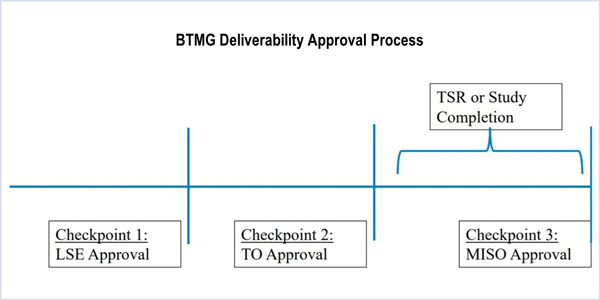MISO has introduced a three-step checklist that owners of behind-the-meter (BTM) generation can use to prove deliverability for the Planning Resource Auction, but some stakeholders are calling foul on the differing auction requirements.
The three-pronged approach will involve different sign-offs from affected load-serving entities, transmission owners and MISO. The LSE will determine whether the BTM customer can participate in the wholesale or retail market, while the TO will ascertain study requirements for access to the transmission system when the BTM generator interconnects to a non-transferred facility. The RTO will determine the resource’s deliverability or transmission service procurement in order to use the transmission system.
“This is meant to provide some guidance on the more intricate relationship between LSEs and TOs,” MISO Manager of Resource Adequacy John Harmon said during a July 12 Resource Adequacy Subcommittee meeting. “MISO is not looking to gain new authority in this endeavor; we’re trying to stay within the bounds of our Tariff.”
Since the beginning of the year, MISO staff have been grappling with deliverability rules that would allow BTM generation in excess of a utility’s planning reserve margin requirement — but without existing transmission service — to enter the annual capacity auction. The RTO last month proposed requiring that a BTM resource submit to an optional engineering study to identify a deliverable volume of capacity eligible to be bid into a single auction. However, the study would have only temporary value. The resource would then be required to enter the same volume into the interconnection queue study process before offering capacity into any subsequent auctions. (See MISO Proposes Deliverability Rules for Behind-the-Meter Capacity.)
Harmon said MISO is proposing to adopt the optional study avenue for two planning years until June 1, 2019. After that, resource owners will have to enter the interconnection queue.
Deliverability amounts discovered in the optional study will have a “limited applicability” and will not be used to determine deliverability in the interconnection queue process, Harmon said.
Indianapolis Power and Light’s Lin Franks asked why BTM generation should essentially be treated as “free riders” on the grid, and not supported by utility aggregators.
“I don’t know of any place where behind-the-meter generation [has] paid for transmission service. They’ve paid nothing whatsoever for access to the Bulk Electric System,” Franks said. “There are some holes.”
Harmon said BTM will only have access on an as-available basis, and that the proposal is an “interim solution” to ushering BTM generation into a more formal interconnection process.
Dynegy’s Mark Volpe asked if MISO was proposing a go-around to the rules that every other capacity resource has to abide by.
“You’ve got a gigantic comparability issue here,” Volpe said.
Harmon pointed out that before this year, excess BTM generation was delivered undetected. “We think there’s good cause for a transition period,” Harmon said. He also added that the proposal might not be “100%” yet, but that MISO and stakeholders are striving toward the same goal.
He asked for additional stakeholder feedback on the deliverability proposal by July 26.
PRA Qualification Deferral to Become a Reality
MISO will file Tariff changes this fall to give certain capacity resources the option for additional time to qualify for the PRA.
The deferral will also be spelled out in the Business Practices Manuals and will allow certain resources to postpone completion of generator verification tests or installed capacity value calculations until after the auction. Capacity resource owners that intend to defer must inform the RTO before Feb. 15 and complete a generator verification test no later than May 31 in order to participate in the upcoming planning year.
MISO uses the verification test to determine the total capacity that a planning resource can reliably provide based on performance and availability data for summer peak conditions.
The draft BPM language states that the deferral is for untested new planning resources, existing resources “returning to operation from a catastrophic outage or suspension,” resources in the midst of increasing capability, suspended resources and resources “awaiting other miscellaneous resource approvals to achieve commercial operation.”
Analyst Scott Thompson said deferrals could also be used by intermittent capacity resources that have yet to come online at the time of the auction or generators that are completing environmental upgrades that prevent operation.
— Amanda Durish Cook





